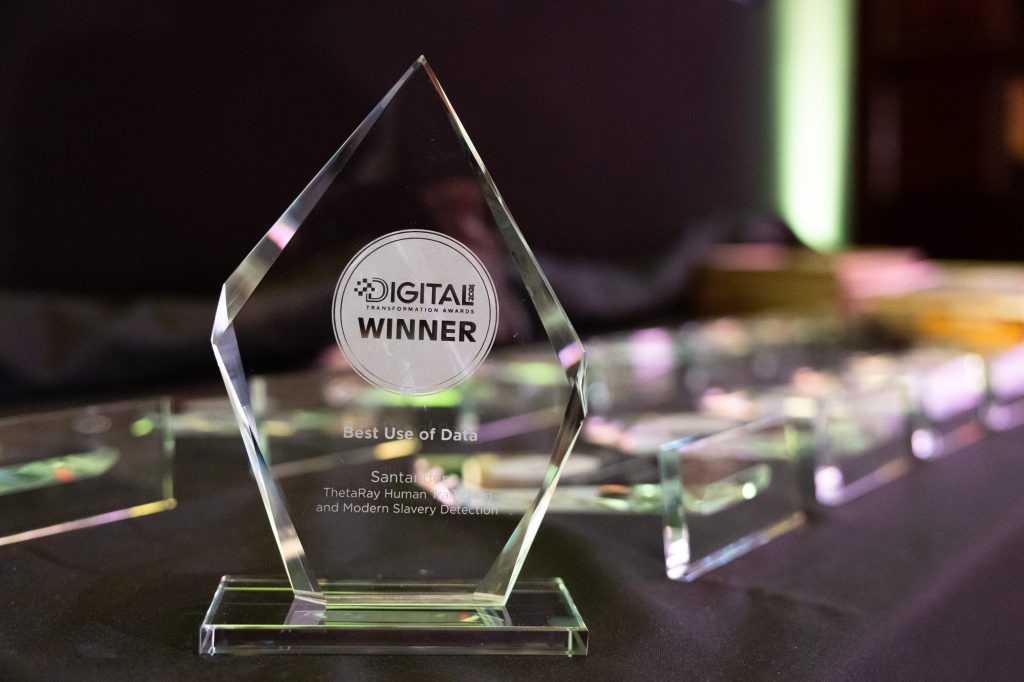How AI and ML is shaping the future of business

This article is published in collaboration with the Digital Transformation and AI Awards and Summit. These are two separate B2B events organised by 31 Media. If you wish to exhibit your tech solutions or to advertise your brand at the event, please get in touch at +44 (0)203 931 5827. Author: Sharon Shofner-Meyer, JD, President and COO of DorothyAI As a business owner myself, I have a front-row seat to witness just how transformative artificial intelligence (AI) and machine learning (ML) can be. These technologies are not just improving conventional techniques — they are transforming the very foundation of business processes. In almost every sector, AI and ML are reshaping the industry, creating new opportunities for business and defining new frontiers for productivity and competitiveness. Transformative Impact on Sectors AI and ML are having profound effects across various sectors: Healthcare: AI is redefining diagnostics by enabling early disease detection and personalised treatment plans. This leads to improved patient outcomes and operational efficiencies. Finance: In this sector, AI enhances fraud detection, optimises risk management through sophisticated algorithms, and refines trading strategies. Logistics and Supply Chain: AI-driven predictive maintenance and route optimisation are revolutionising these areas, leading to more efficient operations. Legal: AI boosts legal research, automates document review, and optimises contract management by predicting case outcomes, improving accuracy, and ensuring compliance. One of the most surprising applications of AI that touches every business sector is patent research and portfolio management. Advanced AI systems can analyse extensive datasets, streamline patent searches and manage portfolios more effectively. This lowers the barriers to innovation, allowing experts to focus on breakthroughs rather than navigating complex and costly patent processes. Challenges and Strategies for Implementation Though 84% of C-level executives believe that they need to adopt and leverage AI to drive growth objectives, integrating AI and ML into business systems comes with its challenges. These include the complexity and cost of implementation, data privacy concerns and the risk of regulatory non-compliance. To navigate these hurdles, businesses should: Invest in Change Management: Prioritise improvements in technology and foster a culture of continuous learning. Ensure Robust Data Sets: Implement AI with accurate and reliable data to avoid issues like data hallucinations that can skew results. Adopt Ethical AI Practices: Establish clear policies for data processing and minimise algorithmic bias through regular audits and transparent practices. Ethical Considerations and Enhanced Decision-Making Ethical integration of AI is crucial for maintaining trust and upholding a positive reputation. Key measures include: Data Privacy Protection: Safeguard sensitive information and comply with regulations. Bias Minimisation: Implement systems to identify and address biases in AI algorithms. By making AI processes transparent and conducting periodic stakeholder audits, businesses can harness AI’s capabilities for improved decision-making. AI-driven analytics offer insights into intellectual property, customer behaviour, supply chain dynamics and product development, enabling quicker responses to market changes and uncovering new opportunities. The AI revolution shows no signs of slowing, with the global artificial intelligence market projected to reach $407 billion by the end of 2027. As AI and ML continue to upend industries, they bring in more opportunities and upsides. Unleashing these technologies to their full potential requires leading businesses to grow new muscles around data literacy, ethics in AI and strategic deployment. Businesses can achieve competitive advantages in an increasingly data-driven world and sustain growth through strategic, thoughtful integration of these diverse technologies. Get in touch For event sponsorship enquiries, please get in touch with calum.budge@31media.co.uk For media enquiries, please contact vaishnavi.nashte@31media.co.uk
How to build a robust digital transformation strategy

This article is published in collaboration with the Digital Transformation and AI Awards and Summit. These are two separate B2B events organised by 31 Media. If you wish to exhibit your tech solutions or to advertise your brand at the event, please get in touch at +44 (0)203 931 5827. Author: Andrew Nieman, Co-Founder of Arro Labs For every headline announcing a company’s digital transformation, there are rarely follow-up stories about failures. However, brands like GE, Ford, and Procter & Gamble have set a precedent by openly sharing their digital transformation challenges and lessons learned. These cases reveal a common thread: failed digital transformations frequently stem from failed communication. This is because building technology is more of a communication challenge than anything else. A critical element that often determines the success or failure of that communication is a digital roadmap. A well-structured digital roadmap guides a company’s efforts and leads to significant operational cost savings for companies with a few hundred or a few thousand employees. A digital roadmap offers a clear, long-term vision of experience goals and supporting technology integrations, which helps align technology investments with true business goals. It should outline major themes, business objectives, and initiatives needed to achieve these objectives. Moreover, mapping dependencies ensures that every initiative is grounded in reality, helping to manage risks and avoid costly pitfalls. Building a Digital Roadmap Here are four critical factors to keep in mind while building a roadmap: Planning: Aim for a Three-Year Outlook One of the critical considerations in building a robust digital roadmap is aiming for a long-term perspective. While many companies limit their planning to one year due to budgeting cycles, leading digital enterprises like Starbucks and Nike plan for three to five years. “If your roadmap looks less than three years ahead, you’re only focusing on BAU tasks—not innovation,” says Tess Rethore, Head of Product Management at Chicago-based Arro Labs. This long-term vision allows companies to anticipate trends and prepare for future needs rather than merely reacting to the present. Cross-Functional Input: Breaking Down Silos Another essential aspect is cross-functional input. Large organisations often face communication challenges due to siloed departments, leading to overlapping or competing projects. A well-executed digital roadmap focuses on value streams rather than functional departments, requiring input from stakeholders across the organisation. This approach can lead to significant cost savings, reducing project churn and inefficiencies. By involving diverse teams in the planning process, companies can ensure that their digital strategies are comprehensive and aligned with the broader business objectives. This can lead them to save 10-20% of their operating costs. Leveraging Advanced Tools: Increase Efficiency Traditional tools like PowerPoint and Excel are often insufficient for managing the complexities of a digital roadmap. Mature organisations should consider more advanced tools that facilitate real-time collaboration and integration with other project management systems. Tools such as Roadmunk offer clear visualisations of priorities, dependencies, and milestones, providing a single source of truth for all stakeholders. This helps avoid version control issues and ensures that decisions are based on the most current information. Mapping Dependencies: Improve Team Collaboration It is crucial to prioritise projects and map out dependencies. For example, if the marketing team’s initiative to capture advanced customer data depends on IT’s CRM replacement project, realistic timelines must be established, and accountability must be maintained. Understanding these dependencies helps manage expectations and coordinate efforts across departments. Getting Started with Digital Roadmapping Despite its importance, many organisations struggle with initiating a digital roadmap. Kathy Hlavac, Head of Research & Design at Arro Labs, recommends starting with a series of cross-functional workshops led by experienced facilitators. These workshops help clarify team projects, address funding and progress issues, and align leadership on the digital strategy. As capital planning within large organisations becomes increasingly competitive, having a well-structured digital roadmap is essential for securing project funding. Projects get approved by people, not companies. Convincing the right people of a project’s urgency and where it fits within the organisation’s broader plans is key to obtaining approval – and an organised digital roadmap is very effective at showcasing this. Quoting CNBC, “People aren’t the problem; it’s the organisation’s failure to communicate effectively with its people that set them up for digital transformation trouble from the start.” This emphasises the importance of building a digital roadmap. It’s more than just a planning tool; it is a strategic asset that can guide teams through the inevitable complexities of a digital transformation. By investing in a comprehensive digital roadmap, business leaders can enhance team communication, reduce costs, and drive innovation, which is essential for remaining ahead of the curve in an increasingly competitive environment. Get in touch For event sponsorship enquiries, please get in touch with calum.budge@31media.co.uk For media enquiries, please contact vaishnavi.nashte@31media.co.uk
How AI and Blockchain Are Driving a New Era of Innovation

This article is published in collaboration with the Digital Transformation and AI Awards and Summit. These are two separate B2B events organised by 31 Media. If you wish to exhibit your tech solutions or to advertise your brand at the event, please get in touch at +44 (0)203 931 5827. Author: Tim Kravchunovsky, Founder & CEO at Chirp Since the inception of the Internet of Things (IoT) concept, its popularity has ebbed and waned. After a long inception phase, IoT went through a huge popularity boom in the 2010s, only to experience somewhat of an anticlimax amid challenges like security, interoperability and data privacy. However, today, innovations like AI and the emergence of new technologies like blockchain are fuelling a renaissance of this sector. The idea of IoT dates back to the 1980s. However, the term “Internet of Things” wasn’t coined until 1999 – the very height of the dot com boom – when British technologist Kevin Ashton first introduced the concept of “things” being connected to the Internet. Working at Procter & Gamble at the time, Ashton touted IoT as a solution for more effective supply-chain management. The IoT boom Yet it wasn’t until after the turn of the millennium, when internet technology became more widespread, that IoT took off. Improvements in wireless connectivity, like 4G and LTE, as well as the expansion of cloud computing, allowed virtually any device to be connected to the World Wide Web. Tech giants like Amazon and Google started investing in IoT, much like they are doing with artificial intelligence today. In 2014, Google made a major foray into the IoT sector with the $3.2 billion acquisition of Nest Labs – a maker of smart thermostats and smoke detectors. Microsoft launched Azure IoT Suite, Amazon introduced AWS IoT Core, and industry leaders like GE and Siemens made their major investments. But, like many innovative technologies that capture the public imagination, IoT expectations outpaced reality. The sector faced certain significant hurdles, which caused growth – and investment – to slow significantly in the late 2010s. Challenges and hurdles One of these problems was the lack of interoperability between devices created by different manufacturers, with little standardisation present in the industry. On top of this, IoT devices faced security attacks and breaches. Take the famous Mirai botnet attack in 2016, which affected millions of IoT devices. And, of course, growth expectations simply didn’t match reality. Many of these issues remain a concern today. The IoT space is still highly fragmented, with many connectivity standards competing for the dominant spot – LoRaWAN, cellular, and Bluetooth. Security issues also remain unsolved. This year’s Bitdefender report found that more than 10 attacks against home IoT devices happen every 24 hours. Yet it also found that the average household has as many as 21 internet-connected devices. So, far from disappearing into non-existence, it seems IoT has quietly revolutionised our daily lives – even if corporations like Google didn’t see the return on investment they had hoped for. And now, new technologies like AI and blockchain are, in turn, ready to revolutionise the IoT sector and solve the challenges that have plagued it since its inception. A blockchain-powered era For example, blockchain and AI can help solve the interoperability dilemma. Instead of creating one dominant connectivity standard, blockchain can act as a universal protocol for all types of networks and devices, connecting disparate technologies and industries. AI’s role would then be to dynamically translate and interpret data across various devices and platforms, quickly. Blockchain also facilitates more secure data storage via decentralised solutions, helping to protect IoT networks from hacks and exploits, while AI tools can be used to monitor networks for attacks and ensure a swift response. Swapping centralised servers for local infrastructure can also help protect data privacy for individuals and organisations. Decentralisation isn’t just about the technical aspect, though. The entire approach of blockchain-based networks is very different from that of tech giants like Microsoft and Google. Decentralised networks are primarily focused on community rather than profit. By distributing the network across multiple nodes, a decentralised approach ensures profits are shared by the individuals who own these devices. This introduces sustainability and equity into the IoT ecosystem, while also ensuring that progress won’t be stunted just because the ROI isn’t hitting sky-high targets. It will be exciting to see what digital innovations will spring from this enhanced IoT technology. With the help of AI and blockchain, IoT is about to have another day in the sun, powering a transformative digital future for businesses and individuals alike. Get in touch For event sponsorship enquiries, please contact calum.budge@31media.co.uk For media enquiries, please contact vaishnavi.nashte@31media.co.uk
The Future of CX: Personalisation, Design and Digital Accessibility

This article is published in collaboration with the Digital Transformation and AI Awards and Summit. These are two separate B2B events organised by 31 Media. If you wish to exhibit your tech solutions or to advertise your brand at the event, please get in touch at +44 (0)203 931 5827. Author: Brian Gavin, Co-founder at Wally As the buying potential of people increases through a diverse set of digital channels and experiences, values apart from the product start to matter. It’s not just the 4Ps of marketing (product, price, place, and promotion) that matter now, but the entire marketing mix (7Ps of marketing – product, price, place, promotion, physical evidence, people, processes). That might have been a lot of jargon, let me simplify it for you. According to a recent McKinsey report, 71% of customers now expect companies to deliver personalised interactions, with 76% of customers willing to switch if they have a bad experience. With the increased penetration of digital platforms into our daily lives, fueled by the massive growth of social media and mobile, your target customers are now experiencing unprecedented levels of connectivity that are driving their expectations. With new technology disruptors emerging every two years, how do we best engage with our target customers? The businesses that adapt will thrive, while those that don’t, risk being left behind. Empathy and AI In today’s quick-moving digital scene, customers want more than just a product—they crave experiences that seem personal and meaningful. Brands that can use the big streams of data gathered from every interaction, whether online or offline have a chance to build stronger ties with their audience. Picture being able to guess what your customer needs before they even know it. By dividing your customer base—spotting your most faithful buyers and those falling through the cracks—you gain the power to tweak their experience. These insights become the basis for making customer journey maps that don’t just work, but amaze. With advanced tools like machine learning and AI-powered chatbots, every point of contact can offer a chance to personalise. Whether it’s smart analytics guiding customers to what they need or chatbots that are smart and understanding, not just robotic, the options are limitless. Let’s face it, we’re in a time where people don’t just like a smooth tailored experience—they expect it. UX Theories in Customer-centric platforms Imagine you as a consumer browsing a site, making a transaction, or leaving feedback. You would want the process to be effortless and tailored to your needs. There cannot be a digital bias when it comes to customer experience as every interaction, no matter small or big should feel like it was designed specifically for the user. Now, moving on to navigation, the biggest code to crack for a seamless digital experience. The smoother and intuitive it is, the more the user feels connected to the brand. Some helpful UX theories such as Hick’s Law (which helps simplify decision-making), Von Restorff Effect (which makes important things stand out), and Serial Position Effect(the psychological concept behind how users remember something) can work wonders in improving your platform experience.Most importantly, think about your customers buying habits. Do you have visitors who experience your brand first on social media or a search engine, browse on a mobile phone and then ultimately make a purchase on a laptop? Too many brands have quickly bolted on to support these channels but left the cohesive, unified experience on the sideline. Turning Insights into Action You’ve heard it before: data is the new oil. Capturing customer feedback is the best way to identify recurring pain points and understand what needs fixing. Analyse your data to identify recurring themes, and take proactive steps to improve them. In fact, I would suggest you use the feedback to shape R&D and tweak the product roadmap. This needs to work in alignment with marketing and sales strategies to meet customer needs. In addition to this, focus on building a strong software infrastructure to improve your cyber-security. As it not only protects your customer data, but translates to a long term customer trust, loyalty and hence a better experience. The best type of customer feedback is sometimes not the obvious. So be creative and go beyond just analysing support inquiries, chat or phone conversations. Expand your reach with Accessibility While the majority of us spend countless hours and resources innovating our products to maximise returns from our target audience. We explore horizontal, vertical, or geographical diversification to reach new markets. Yet, we often overlook a substantial untapped audience. Consider this, 15% of the global population, or about 1 in 6 people, live with significant disabilities. These customers are very much part of our ideal customer profile but they never hear from most of us, just because our digital platforms are not accessible. Digital accessibility is about ensuring your offerings are available to everyone, including those with disabilities. It requires your digital platforms, such as websites and mobile apps, to be accessible via assistive technologies like screen readers, screen magnifiers, keyboard navigation, and dictation software. By making your brand accessible, you’re not just showing your commitment to inclusivity; you’re also improving your website’s SEO. Accessibility should be inherently built into your digital platforms—incorporated into your website’s code, design, and content. Your customers will thank you, and you’ll gain a competitive edge in the market. This pairs perfectly with personalisation and intuitive design strategy. A Roadmap While the digital and physical worlds are converging, I expect omni-channel, unified-commerce or experience-driven integration as the norm, setting new standards. Imagine ordering a product online, and being able to return it in-store no matter where you are with a smooth experience. That’s the future. Hyper personalisation is another trend that is picking up fast. Hyper personalisation, unlike personalisation which uses historical customer data, uses real-time data to provide a more customised and contextually relevant experience to users.I also expect accessibility to be built-in very soon. Integrating accessibility into your product from the start is not only
5 tips from an AI expert to beat deepfakes

Over half of Brits (53%) either haven’t heard of the term deepfake or have misunderstood its meaning, with only 17% feeling confident in their ability to spot them. Meanwhile, two in five have encountered at least one deepfake in the past six months, as recent reports reveal that over 4,000 celebrities have fallen victim to deepfakes, and 400 digitally altered images of UK female politicians have appeared on a sexually explicit website. In light of this, the experts at AIPRM have compiled five expert tips for spotting deepfakes and protecting yourself from falling for fabricated content. Key points: Fake news often exploits emotional triggers to distort your judgement. Oddities in facial features such as the shape of the face and ears, are telltale signs of a deepfake. Watch for misalignment between audio and visual cues, especially with letter sounds like M, B and P. Disinformation is ranked as a top risk for 2024, with deepfakes emerging as one of the biggest AI threats. Crack the code: 5 pro tips from an AI expert to beat deepfakes Verify the source and context Fake news spread more rapidly than true news on X (previously Twitter), a concerning trend given that almost two-thirds of young adults in the UK rely on social media as a regular news source. Always examine the credibility of the sources behind the content you consume. Is this information coming from a reputable news outlet or a verified official account? If the source is unfamiliar or looks dubious, cross-check the content’s authenticity using reliable news organizations or fact-checking platforms like Google Fact Check Tools. Remember that misinformation often plays on emotional triggers like fear, anger, or outrage to cloud your judgment. When you encounter content that provokes strong emotions, pause and re-assess to ensure you are not being used as a pawn in someone’s game. Observe facial expressions and movements Deepfakes often falter when trying to replicate the intricate details of facial expressions and natural movements. Key areas to scrutinise include microexpressions around the eyes and mouth. Look out for unnatural blinking patterns, disjointed eye movements, or jerky head motions, and check whether the facial expressions align with the conveyed emotions. Details like the uniformity of teeth, hair texture, and facial structure can also reveal deepfakes. For example, Chris Umé’s viral deepfake of Tom Cruise performing a coin trick in 2021 was so convincing that 78% of viewers couldn’t distinguish it from real content. A key giveaway is the shape of the face and ears – deepfakes often have slightly off measurements in these areas, with ears being particularly difficult to replicate. Pausing the video and examining the facial features can help you spot these irregularities. Just as with the infamous deepfake of Obama calling Trump ‘a total and complete dips**t’ – how convincing does this look to you? Credit: Tiktok @deeptomcruise Credit: Youtube @BuzzFeedVideo Use reverse image and video search tools Leverage reverse image and video search tools to trace the origins of visual content. Uploading an image to Google Reverse Image Search can help identify if it’s AI-generated, manipulated, or being used out of context. For videos, tools like InVID can dissect footage and check for any modifications or previous appearances. These searches allow you to find other copies of the image online, helping you verify its authenticity and uncover potential misuse. Look for digital artefacts and inconsistencies Deepfakes often reveal themselves through subtle digital flaws like blurriness or unnatural pixelation, especially around the edges of faces or objects. Pay attention to inconsistencies in lighting, shadows, reflections, or even an extra finger, that might indicate manipulation. Don’t forget to check the background for distortions or irregularities that throw off the scene’s overall coherence. The viral deepfake of Pope Francis in a Balenciaga puffer jacket from last year showed clear anomalies like distorted glasses fused to his cheek and blurred fingers closed around thin air instead of the coffee cup he’s holding, yet still fooled many online. One fun way to sharpen your detective skills is by practising with the Which Face is Real game created by professors at the University of Washington. The more you play, the better you’ll become at recognizing the patterns of AI-generated content. Check for audio-visual synchronisation Spotting a deepfake often comes down to watching the lips closely. Our mouths form specific shapes when pronouncing certain letters, and these movements are tricky for AI to replicate accurately – nearly a third of deepfake videos struggle to match sounds like M, B and P. If you notice the speaker’s lip movements don’t quite align with the sounds they’re making, or if there are oddities in tone or pitch, it’s a red flag. A notable example is a deepfake video of Mark Zuckerberg, where subtle mismatches between his speech and lip movements exposed the manipulation. AI expert at AIPRM, Christoph C. Cemper, commented: “The World Economic Forum has flagged disinformation as a top risk for 2024, with deepfakes emerging as one of the most alarming uses of AI. If you come across a potential deepfake, the best course of action is to refrain from sharing it. The power of a deepfake lies in its ability to spread, and its impact diminishes if it doesn’t disseminate widely. If you see someone else sharing it, take a moment to courteously inform them and point them to reliable fact-checking resources, especially if the fake has been debunked. Additionally, leverage reporting features on social media platforms to limit its reach. We all must play a role in raising awareness – share your experience and insights on how you recognised deepfakes to help others counteract similar threats. By staying vigilant about the content we consume online, we can collectively fight misinformation and safeguard the integrity of our digital environment.” Upcoming events and contact information Register for The National DevOps Conference and Awards taking place on the 22nd and 23rd of October 2024 in London. For sponsorship enquiries, please contact calum.budge@31media.co.uk For media enquiries, please contact
Enhancing Mobile SDK Security in the Age of Increasing Threats

This article is published in collaboration with the National DevOps Conference & Awards taking place in London on the 22nd and 23rd of October. Find more details here: National DevOps Conference & Awards 2024 Author: Chris Roeckl, Chief Product Officer at Appdome The mobile app economy relies on transaction systems to ensure safe and valid transactions. As mobile becomes the de-facto way that consumers interact with the brands they use in their daily lives and work, regulatory scrutiny is increasing to ensure the payment or in-app purchase transaction is compliant with guidelines, stopping fraudulent or otherwise risky transactions. Software development kits, or SDKs, are at the heart of these transactions, and embedded into the apps we use every day. With the popularity of mobile exploding, mobile is becoming (sadly) the de facto platform of choice for bad actors to increasingly try to compromise these critical technology components. Because of this, mobile SDKs face numerous security challenges. One significant issue is reverse engineering, where attackers decompile the SDK to uncover its code and logic, potentially stealing intellectual property. To combat this, obfuscation is used, with increasingly the best practice being to encrypt strings and preferences within the SDK, without affecting useability and performance. Another prevalent problem is the risk of data interception. Sensitive data stored within the app or transmitted to servers can be intercepted by malicious actors. It’s more important than ever that SDKs mitigate this risk by encrypting data both at rest and in transit, ensuring that sensitive information remains protected from unauthorised access. Standards groups and transaction processors, like Visa and EMVco, have now mandated that mobile devices that have been rooted or jailbroken pose transaction risks, and therefore any such compromised device is not allowed to process a transaction. Why, jailbroken or rooted devices can bypass standard security mechanisms, making it easier for attackers to exploit vulnerabilities? There are more, but I think you get the idea of the threats. The other confounding variable is how to stop non-compliant transactions in real-time. Securing Mobile SDKs: Real-Time Threat Detection and Compliance for a Safer Mobile App Economy To stop non-compliant transactions in real-time requires real-time monitoring and reporting of security events and threats as they occur within the SDK during the flow of the transaction itself. With this developers and security teams have immediate visibility into security incidents, enabling real-time validation or denial of transactions as required by transactions processors and regulatory bodies. This approach destroys the old-world model of traditional fraud and security systems that cannot detect threats in real-time, meaning non-compliance due to delays in identifying and responding to security incidents. With this data in hand, mobile SDK makers can easily meet compliance objectives. More importantly, mobile SDK makers can create, customise, and use simple or complex threat streams to consume fraud, attack, threat, and risk data in the mobile SDK in real-time. The result is better decision-making and fraud prevention, without compromising service quality or the consumer’s mobile app experience. Real-time systems also can go beyond the minimum requirement and look for additional signals of activity that may be indicative of fraud behaviour or what may lead to a non-compliant transaction. Some solutions, for example, can look for hundreds of attacks during the follow, providing incredibly valuable insights for SDK markets at banks, fintechs, and other transaction-minded firms. However financial transactions are not the only segment that can benefit from SDK protection and real-time data about threats and attacks. Think authentication and identity verification, advertising, analytics, push services, and more. All this sounds like a lot of work for developers – build the protections to obfuscate and encrypt the IP, build real-time protections for jailbreak/root and potentially dozens of others and keep those protections up to date along the way, and build and event reporting with listeners in the SDK and the back-end infrastructure. Yup, for sure, it’s a ton of work. Thankfully automated systems have emerged to translate all this work down to the click of a button for dev and cyber engineering teams, be it an SDK or a mobile app. Such systems can keep your SDKs secure, and compliant, and provide real-time data for ensuring a valid transaction, to prevent ad SDK fraud, facial identity bypass, and many, many other use cases as well. As mobile continues to dominate as the primary platform for consumer interactions, ensuring the security and compliance of embedded SDKs has never been more critical. The increasing threat landscape, combined with stringent regulatory requirements, necessitates robust security measures that can detect and prevent fraudulent activities in real-time. Automated solutions now offer comprehensive protections, from obfuscation and encryption to real-time threat monitoring, addressing the myriad of security challenges faced by mobile SDKs. By leveraging advanced automated systems, developers and security teams can significantly reduce the complexity and effort required to implement these protections. This enables them to focus on delivering high-quality, secure, and compliant applications, ensuring a safe and seamless experience for users. As the mobile app economy evolves, staying ahead of threats and regulatory demands will be paramount, and embracing innovative security solutions will be key to safeguarding the integrity and success of mobile applications in this dynamic landscape. Upcoming events and contact information Register for The National DevOps Conference and Awards taking place on the 22nd and 23rd of October 2024 in London. For sponsorship enquiries, please contact calum.budge@31media.co.uk For media enquiries, please contact vaishnavi.nashte@31media.co.uk
Digital Transformation Awards 2025: Accepting Entries till 14th May

Organised and hosted by 31 Media, the Digital Transformation Awards is an independent awards program that recognises and celebrates businesses, teams and individuals that are revolutionising the digital landscape as we know it with their digital transformation projects. After a successful gala night in London this year, the awards programme is officially open for entries for the 2025 edition. The entries will be open until 14th of May 2025 and the gala night is scheduled to take place in June 2025. Please find more details here: Digital Transformation Awards 2025 About the Digital Transformation Awards CELEBRATING EXCELLENCE The Digital Transformation Awards stand as an independent program that confidently recognises and celebrates the outstanding achievements of businesses, teams, and individuals who have excelled in delivering digital technologies to enhance or modify business processes, customer experience, or cultural change. A HOLISTIC PROGRAMME The Digital Transformation Awards welcome participants from all businesses, individuals, teams, and groups, irrespective of their location, size, or discipline. The sole requirement is that the digital transformation project must have occurred or been completed within 12 months prior to entering. IMPARTIALITY & TRANSPARENCY The Digital Transformation Awards are judged with absolute impartiality and complete transparency to ensure a level playing field for all. To achieve this, each entry submission is meticulously stripped of any reference to a product, service, company name, individual, or otherwise. This process empowers the judging panel to assess each entry without influence, solely on the merit of the project at hand. PROJECT RECOGNITION The time, energy, and commitment invested in each project are significant. It is essential to receive internal and external recognition for these efforts. Participating in the Digital Transformation Awards ensures that each project, team, or individual receives the necessary acknowledgment, leading to increased visibility for the entire business. NETWORKING & BUILDING RELATIONS Attending the gala dinner and participating in the winner’s ceremony is a delightful and rewarding experience. It provides the opportunity to mingle with numerous professionals who share similar aspirations, fostering connections and expanding your professional network. WINNING & CELEBRATION Making it to the finals of the Digital Transformation Awards is a remarkable accomplishment. Winning one of the coveted trophies is an extraordinary achievement that should be celebrated. To be judged by a panel of your peers, all of whom agree that your submission is head and shoulders above all others, creates enormous pride and a wonderful sense of achievement. Transmitting the win internally reinforces the success and commitment of the business to Digital Transformation, and further marketing yourselves as an award-winning company truly represents the ultimate celebration and pinnacle of success. For more information on the entry process and guidelines, visit Digital Transformation Awards Entry Process. Upcoming events and contact information Register for The National DevOps Conference and Awards taking place on the 22nd and 23rd of October 2024 in London. For sponsorship enquiries, please contact calum.budge@31media.co.uk Foe media enquiries, please contact vaishnavi.nashte@31media.co.uk
Accelerate software delivery with monitoring and observability

#NDCA2024 Speaker Edition In collaboration with The National DevOps Conference and Awards, we interviewed #NDCA speaker, Marvi Cotone. The conference & Awards takes place in London on the 22nd and 23rd of October 2024. To exhibit your products at the event, please get in touch here. Author: Marvi Cotone, Deputy Director of Digital Delivery & Architecture at Homes England. She is also a keynote speaker at the National DevOps Conference and Awards Accelerating software delivery is not just about moving faster – it’s about moving smarter. To succeed in this fast-paced digital landscape, organisations must balance speed with quality, ensuring that the software they deliver is both reliable and valuable to users. To achieve this, monitoring and observability should be viewed not just as technical necessities, but as strategic advantages. Monitoring vs. observability and their strategic importance In the world of DevOps, monitoring and observability are often mentioned together, and sometimes even used interchangeably. However, while both aim to help organisations understand and manage complex IT systems, they take different approaches and provide unique insights. At its core, monitoring is about collecting data. According to Google’s DevOps Research and Assessment (DORA), monitoring involves using tools to track predefined metrics and logs to understand a system’s state. It’s a long-established practice, dating back to the early days of computing (Remember the old friend Norton Disk Doctor?). However, monitoring is catching known issues but often lacking the depth needed to uncover new problems or provide actionable insights. This is where observability comes into play. Observability goes beyond monitoring by allowing teams to diagnose and debug systems through the analysis of data. It offers a proactive approach, helping teams identify new issues and their root causes more quickly. In essence, monitoring tells you when something is wrong, while observability helps you understand why it’s happening. As mentioned previously, for organisations aiming to deliver high-quality software at speed, monitoring and observability are not just technical practices—they are strategic tools. Together, they enable teams to continuously deliver value to users by maintaining a balance between speed and quality. Monitoring provides a real-time view of system performance and alerts teams when predefined thresholds are breached. However, simply collecting metrics isn’t enough; these metrics must be effectively analysed and interpreted to provide meaningful insights. Observability complements monitoring by offering deeper insights into system behaviour. It helps teams understand not just what went wrong, but why it went wrong, enabling faster resolution of issues and better system transparency. When integrated into the development process, monitoring and observability streamline operations, enhance system performance, and improve the efficiency of software delivery cycles. Implementing effective monitoring and observability frameworks The key factor when implementing effective monitoring and observability frameworks is adopting a mindset that promotes flexibility. It’s essential to adopt tools that support the team’s goals without imposing unnecessary burdens or forcing the adoption of new technologies that don’t align with existing processes. Here are some key considerations for successful implementation: Follow best practices but stay flexible: While it’s important to adhere to industry best practices, teams should also be open to experimenting with different approaches. This flexibility allows them to continuously improve their processes and find the tools that work best for their specific needs. Focus on people, not just technology: The success of any monitoring and observability framework extends beyond tools and processes. It requires a focus on the people who manage and use these systems. Teams should approach implementation iteratively, focusing on the vision they want to achieve rather than getting bogged down in the technical details. Incorporate user experience data: To truly succeed, observability frameworks should also incorporate user experience data—both synthetic and real-user monitoring. This allows teams to identify issues before users do, leading to better-designed user experiences and continuous improvement of digital offerings. Enhancing visibility and communication One of the most significant benefits of monitoring and observability is the increased visibility they provide into systems. This visibility is crucial for making informed decisions that align software development with business goals. By understanding the impact that digital systems have on the business, organisations can make better decisions about where to focus their efforts and continuously improve their digital offerings. Moreover, monitoring and observability foster better communication within teams. They provide a shared view of system performance, making it easier for teams to collaborate and resolve issues quickly. In conclusion, implementing monitoring and observability is not just about ensuring stability—it’s about empowering teams to deliver better software, faster, and with greater confidence. When implemented thoughtfully, they become key enablers of long-term success. Hear Marvi Cotone speak at the National DevOps Conference 2024 Join us for an in-depth presentation on monitoring Vs observability at The National DevOps Conference and Awards, happening in London on October 22nd and 23rd, 2024. This premier event will feature expert insights into how AI is transforming DevOps practices and the broader tech industry. View the Full Agenda: The National DevOps Conference and Awards Agenda Exclusive Offer: Gain free entry to the conference by submitting your project to the DevOps Awards before the September 16th deadline. Don’t miss this opportunity to showcase your innovation and network with industry leaders. For exhibit at the conference, please contact calum.budge@31media.co.uk Foe media enquiries, please contact vaishnavi.nashte@31media.co.uk
How AI is revolutionising DevOps

In theme with The National DevOps Conference and Awards, we collaborated with Matt Healy, Director of Intelligent Automation Strategy at Pegasystems. In this article he explores how Artificial Intelligence is revolutionising DevOps. The National DevOps Conference & Awards takes place in London on the 22nd and 23rd of October 2024. To exhibit your products at the event, please get in touch here. Is AI the end of never ending DevOps transformations? For almost a decade, I was a release manager for large scale development teams –supporting 1000’s of developers across 100’s of teams working on 10’s of products and initiatives. For that whole decade, my focuses were two-fold, managing the Software Development Life Cycle (SDLC) and improving the SDLC. Managing and improving the SDLC The management part consisted of making sure that we were getting secure, high quality, releases out the door on time. In order to support developers, teams, and the overall programme with better and better tools, practices, and processes, the SDLC had to be improved, so the second part of the role. It was in the ‘improving the SDLC’ aspect which highlighted how DevOps could transform and create a place where big initiatives were planned early and often, enabling teams with full backlogs. User stories could be quickly elaborated on, to ensure that teams cover all considerations, acceptance criteria, standards, and unhappy paths as they plan without taking weeks. As well as ensuring that developers had the tools and knowledge they needed at their fingertips to surface best practices, how-to’s and suggestions for both new and experienced developers. Further, it is key to make sure that there was healthy automated test coverage, in which developers had the test frameworks and starting points they needed to quickly generate automated tests at every level. Merges and deployments also need to be fully automated. This would enable change to be pushed from a developer’s system through to a pre-production or even production environment with confidence in automated controls around quality, security, and performance. Finally, an aggregated and actionable feedback loop is important across sources like usage analysis, user interviews, and market data, so teams could have insights into how they could improve features and drive adoption. AI in DevOps: Automating repetitive tasks for efficiency While we made significant progress against all of these goals, it never felt like we were ‘done’, and we probably never will be. But artificial intelligence (AI) will bring us closer to the DevOps promise land at every stage across the SDLC. The opportunity for AI to help large scale development teams is clear. AI will offload repetitive manual development tasks, which has already been seen with development efficiency gains in copilot capabilities with AI being able to take a first pass at workflows, integration mapping, user experience components, and more – and this is expected to become even more omnipresent. For developers, AI will put knowledge at their fingertips. There has already been a rise of AI-driven search, and even now personalised AI tutors who can help developers of all levels get up to productivity fast. Looking at operations more generally, AI will be able to synthesise product optimisation opportunities through analysing historical process mining data to uncover and prioritise the biggest inefficiencies and opportunities for product teams to go after. Planning with AI: Transforming large-scale initiatives Working on large-scale initiatives, which involved dozens of teams, and required buy-in from multiple leaders, it felt impossible to get ahead in the planning stage and for this to be optimised. With weeks of meetings, workshops, documents, spreadsheets, roadmaps, architecture diagrams, all to get to a list of user stories which teams could actually start developing, but AI has even started to transform how we plan. With generative AI, IT teams now have a discovery and planning assistant, which can aid them in evolving legacy assets into future-ready workflows. AI can help across planning stages looking at: Level setting: analysing historical analyses and legacy assets like workflow diagrams and user manuals to understand the current state. Research: combing through industry expertise to understand the best practices and possible approaches. Alignment: capturing all business goals and considerations from across stakeholders and synthesising them into a coherent, all-encompassing vision. Essentially, generative AI can be the spark to get started. Setting a foundational design for new initiatives which lets teams hit the ground running and collaborate on, fast. Over the past 12 months, great progress has been made with tangible value in some of the toughest-to-manage areas across the SDLC, so we are on the way to the AI promise land – this is just the beginning. Explore AI and automation at the National DevOps Conference in London Join us for an in-depth discussion on the scope and future of AI and automation at The National DevOps Conference and Awards, happening in London on October 22nd and 23rd, 2024. This premier event will feature expert insights into how AI is transforming DevOps practices and the broader tech industry. View the Full Agenda: The National DevOps Conference and Awards Agenda Exclusive Offer: Gain free entry to the conference by submitting your project to the DevOps Awards before the September 16th deadline. Don’t miss this opportunity to showcase your innovation and network with industry leaders. For exhibit at the conference, please contact calum.budge@31media.co.uk Foe media enquiries, please contact vaishnavi.nashte@31media.co.uk
Embracing CI/CD for Improved Software Deployment and Developer Health

This article is published in collaboration with The National DevOps Conference and Awards.To be a speaker at the conference or to exhibit your solutions to our delegates, please get in touch here. As part of the #LeadersInTech series, we collaborated with Rob Reid, Technical Evangelist at Cockroach Labs on how developers can embrace CI/CD for improves software deployment and developer health. I’ve never been woken up at 2 a.m. by a company that uses CI/CD. Put another way, for software developers, the use of Continuous Integration (CI) and Continuous Deployment (CD), or CI/CD, for software development, testing and deployment is a game changer for maintaining code quality, smooth processes, and ensuring reliable releases. It transforms the development lifecycle, allowing teams to focus more on innovation rather than firefighting issues. And for preventing those 2 a.m. fire drills. Continuous Integration involves the integration of code changes into a shared repository multiple times a day. Automated tests are run to detect errors early, ensuring that the codebase remains stable. This continuous integration supports a proactive approach to problem-solving, substantially decreasing the likelihood of disruptive, last-minute discoveries. Continuous Deployment, on the other hand, focuses on automating the release of validated code to production environments, streamlining the entire deployment process. This tightly integrated testing and deployment process ensures high compatibility and operational reliability, which are critical for our users’ success. This approach also ensures that every version of the application works harmoniously with CockroachDB before reaching production. Benefits of CI/CD The primary benefit of CI/CD is maintaining a clean main branch of code, ready for release at any moment. This practice instills confidence in developers, knowing that their code is always in a releasable state. Additionally, CI/CD ensures reproducibility, allowing the deployment process to be consistent across different environments. The importance of automated testing in CI/CD cannot be overstated. Automated regression tests catch bugs early, enabling developers to make bold changes without fear of breaking the codebase. This leads to a more dynamic and innovative development environment. Best Practices for CI/CD: Treat Infrastructure as Disposable: Adopt the mindset of treating infrastructure like “cattle, not pets.” For example, use automated scripts for provisioning that quickly replace faulty instances without manual intervention, enhancing scalability and reliability. Automate Everything: From testing to deployment, automate as many processes as possible. This reduces the risk of human error and ensures consistency across deployments. Comprehensive Testing: Ensure that tests are integral to the process. Proper test coverage provides confidence in the codebase, allowing for more significant changes and refactoring. Feature Flags: Use feature flags to safely release new features. This allows for “dark releases”, where features are deployed but not activated until needed, providing a quick rollback mechanism if issues arise. Eliminate Bureaucracy: Avoid unnecessary release reviews and approval processes. Focus on building a robust CI/CD pipeline that allows for high-velocity development and deployment. The impact of CI/CD on developer health The adoption of CI/CD not only improves technical operations but also has a profound impact on developer well-being: no more fear that you will bring your company’s IT to a grinding halt because of a “fix” or addition that broke the codebase! Automated processes and the ability to trust the tools rather than relying solely on personal interventions leads to a more balanced work-life experience and better overall results. I have also found that when the CI/CD mindset gets set from the top, at the executive level, there is a healthier work balance for the developer. Counter to this are companies that reward the “hero culture” of software releases which start at 2 a.m.. A culture of being rewarded for fixing production issues rather than preventing them not only increases stress but also slows down development as manual interventions become the norm. CI/CD processes are not just technical practices; they represent a shift towards a healthier and more efficient development culture. By automating processes, ensuring comprehensive testing, and eliminating bureaucratic hurdles, companies can create a more dynamic and innovative environment. For organisations still on the fence about adopting CI/CD, it’s crucial to understand that the initial investment in building a robust CI/CD pipeline pays off significantly in the long run. The result is not only a more reliable and scalable codebase but also a happier, healthier team ready to tackle the challenges of modern software development. Learn more about CI/CD practices at the National DevOps Conference 2024 Join us for an in-depth presentation on CI/CD practices at The National DevOps Conference and Awards, happening in London on October 22nd and 23rd, 2024. This premier event will feature expert insights into how AI is transforming DevOps practices and the broader tech industry. View the Full Agenda: The National DevOps Conference and Awards Agenda Exclusive Offer: Gain free entry to the conference by submitting your project to the DevOps Awards before the September 16th deadline. Don’t miss this opportunity to showcase your innovation and network with industry leaders. For exhibit at the conference, please contact calum.budge@31media.co.uk Foe media enquiries, please contact vaishnavi.nashte@31media.co.uk


